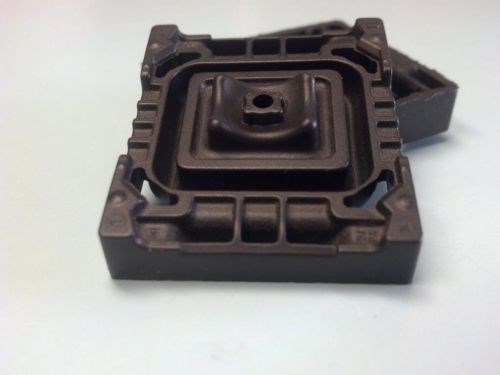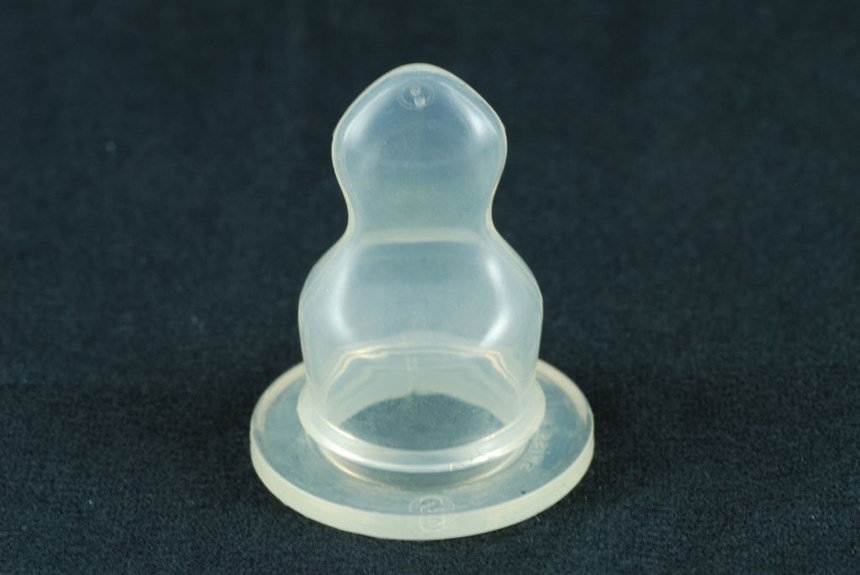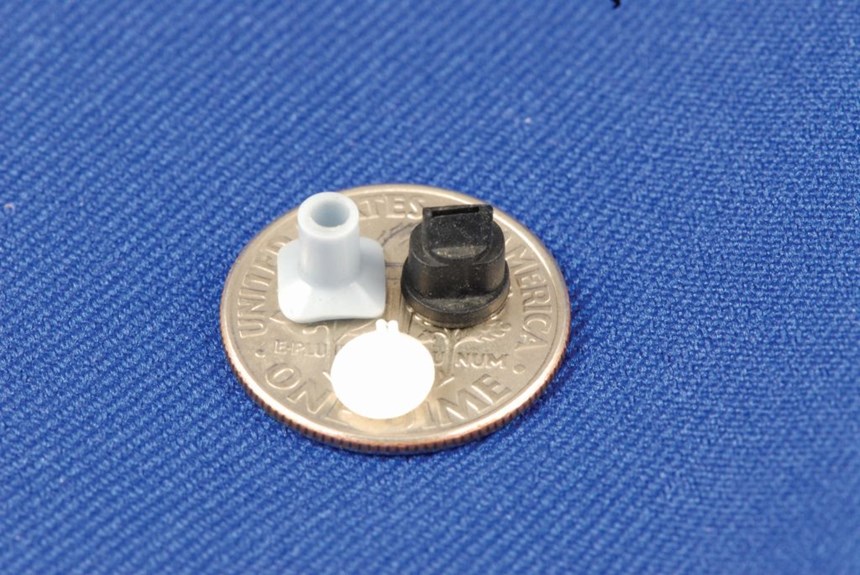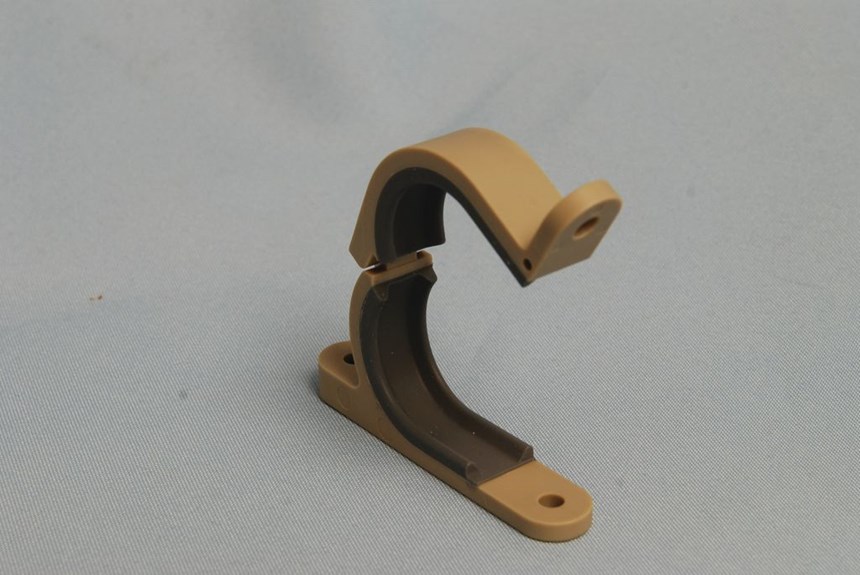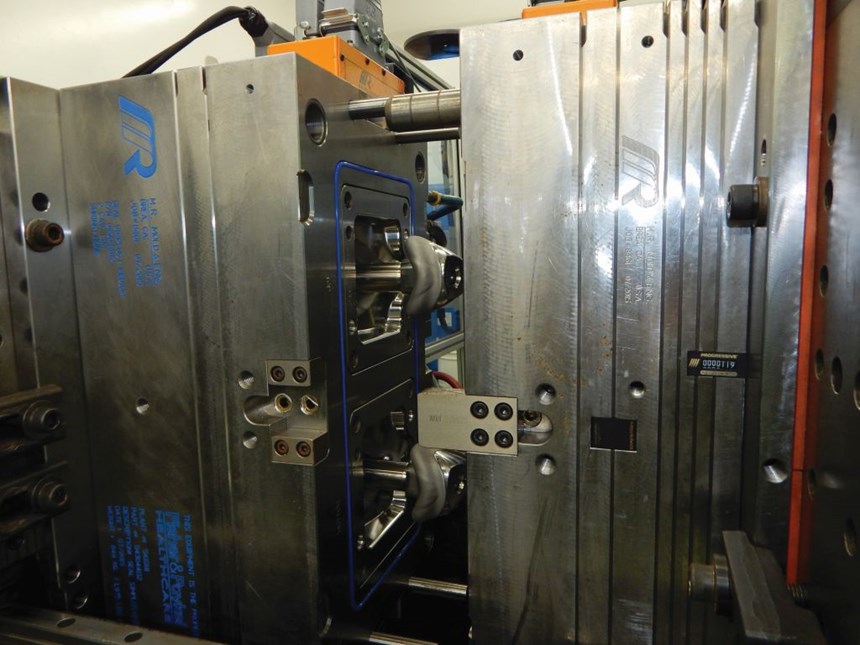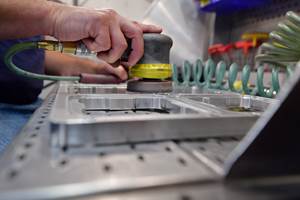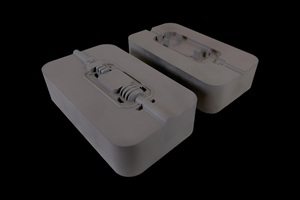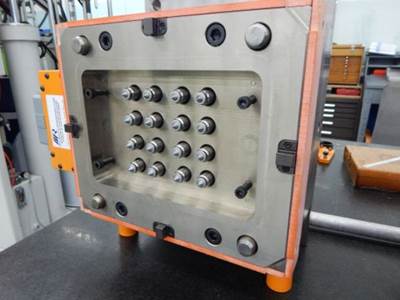The LSR Learning Curve
This increasingly popular thermoset material follows very different rules than any plastic.
At M.R. Mold & Engineering, orders for plastic injection tooling often inspire high fives on the shop floor. “I hope this doesn’t offend some of my friends in the industry, but we’ve found that plastic molds are just easier,” says Rick Finnie, company president. Although M.R. Mold churns out plenty of those, its true competitive edge is expertise in liquid silicone rubber (LSR), a free-flowing thermoset material.
This is an edge that’s proven particularly lucrative lately. Thanks largely to expanding use of this thermoset material, the pace of this Brea, California, company’s growth has been unprecedented during the past few years, Finnie says.
However, he emphasizes that market forces alone would never have been enough for the company to become one of the few go-to sources of LSR tooling on this continent. A specialized sector requires specialized knowledge, and gaining the ability to deal effectively with requirements foreign to thermoplastic tools took years of experimentation and a commitment to prioritize this work over all else. The case is the same for developing niche processing expertise that’s in high demand among molders and OEMs moving into this sector. In fact, M.R. Mold even markets its own auxiliary products, which run the gamut from material feed to part ejection (learn more in this companion article).
Having come this far, Finnie and the rest of the company’s leadership are confident that M.R. Mold will maintain its reputation for LSR for as long as these applications are in demand. In the meantime, he says they’re more than happy to share their expertise with the broader industry.
Catching a Wave
M.R. Mold hasn’t always been known for LSR. Founded as a rubber compression and transfer moldmaker by Finnie and a single employee in 1985, the shop grew steadily until the industry experienced an exodus of work overseas around the turn of the century. With previous experience in building molds for this thermoset material, he and his team saw an opportunity to emphasize LSR work and carve out a niche.
The shop hasn’t looked back, and the time and effort required to truly master LSR has proven well worth it. Sales are expected to reach the $5 million mark for the first time ever this year, and LSR constitutes about 90 percent of that business, says Geralyn Anderson, marketing director. During the past few years, the 15,000-square-foot facility has added six new employees, bringing the grand total to 30, and added a slew of new equipment, including a high-end Yasda VMC, a laser engraver, a new injection press (the shop has five) and more. Nonetheless, backlogs reached unprecedented levels in 2014 and 2015.
This activity is being driven largely by OEMs finding new applications for LSR, Anderson says, particularly in the medical and consumer products industries. In addition to being fully biocompatible, the material tolerates harsh chemicals and extreme temperatures. That makes it useful for medical devices subjected to high heat during sterilization, or perhaps bakewear that can be stored in a freezer, Anderson points out. It’s also ideal for overmolding onto certain plastic, whether for instrument panel keypads or biocompatible (and comfortable) surgical instrument handles. Another advantage of LSR is flexibility. The material is not only strong, but also highly elastic. Additionally, its viscosity in liquid form is so low that it can fill cavities that are far too small for molten plastic.
A Different World
However, even the most experienced thermoplastic toolmaker or molder will find that certain strategies just don’t translate to LSR, which is processed very differently, Finnie says. For one, there are no hardened pellets in these applications. Rather, the material ships as two separate compounds, both with a thick, paste-like consistency. Blending these compounds in a mixing/metering system (whether a press-mounted unit or an auxiliary device) creates a chemical reaction that, along with heat, drives the material to cure into a solid. Keeping it in the liquid state for molding is accomplished via a water-cooled injection barrel and/or runner system, and the mold itself is zone-heated to temperatures ranging from 300°F to 400°F.
Suffice it to say that a different process for a different material requires different thinking, from the design of the tool all the way through part ejection from the press. Here are a few examples that Finnie cites as most significant:
• Cold manifolds. As is the case with thermoplastic applications, many LSR molds feature runnerless construction—that is, one that delivers material via a dedicated manifold that leaves no runners or sprues to eject with the part. The difference is that LSR manifolds feature water-cooled channels rather than the heaters employed by plastic injection mold hot runners.
The advantages are similar for both types of tooling. Namely, cycles are faster because there is less material to process, and having no runners to remove facilitates demolding automation. However, these advantages are more pronounced with LSR, Finnie says. One reason is that curing LSR tends to take longer than cooling plastic, Finnie says. That translates to greater cycle time improvements, particularly for small parts that that might weigh less than a traditional runner. What’s more, LSR can’t be reused once cured, and the material tends to be more expensive than plastic resins.
• Closer fits. Regardless of whether the design calls for a cold deck, the toolmaker has to contend with the fact that LSR flows like water in its heated, liquid state. In fact, its viscosity is so low that it will flash into gaps as small as 0.0002 inch, Finnie says. That means plates must be parallel and flat, fits and clearances are critical, and only the highest levels of precision will do. “I’ve had some knowledgeable people in this industry say they won’t accept a drawing with less than five thousandths flash extension,” Finnie says.
• Vacuum sealing. Such tight fits don’t leave much room for venting air and any residual gasses from the cavity prior to material injection. Adding to this challenge is the fact that LSR undergoes a gas-creating chemical reaction when the two constituent components are mixed. Thus, these applications typically require vacuum pumps to help clear cavities of all gasses immediately prior to injection. Proper application of a vacuum pump also requires an air-tight seal around the entire parting line, typically in the form of fitted silicone strips.
• Tighter gating. LSR’s low viscosity has implications beyond fits and clearances. “Large gates are one of the biggest giveaways that a silicone mold was made by a plastic shop,” Finnie says, noting that a typical LSR gate might measure only 0.003-inch deep. Smaller gates lead to other considerations as well. For instance, smaller runners should be fully round if possible to avoid breakage, and standard plastic-injection sprue bushings are usually far too large to achieve efficient cycle time in an LSR application.
• Tighter venting. What’s more, the use of a vacuum pump doesn’t preclude the need for dedicated vents. Given the risk of flash, those vents are typically far smaller—and more demanding to machine—compared to their plastic industry counterparts. Most measure 0.0001 or 0.002 inch deep, whereas plastic mold vents don’t trend much smaller than 0.0005 inch or so, Finnie says. At M.R. Mold, vents might be milled, ground, burned or even laser-machined within depth tolerances measured in the millionths of an inch.
Similarly to many plastic toolmakers, M.R. Mold employs Sigmasoft virtual molding software from Sigma Plastic Services Inc. to ensure vents are located at the last place in the cavity where material will reach. However, this tactic is particularly critical for LSR molds, because the need for tight fits between components in these tools presents fewer options for venting. For instance, straight-walled ejector pin holes can’t double as vents in LSR tooling, because the material would flash into the gap surrounding the pin. Only a tapered shutoff will do.
• Fewer moving parts. Ejector pins aren’t the only common mold component missing from most LSR tools. These molds don’t usually incorporate slides, lifters or other moving actions either. That’s because undercuts simply aren’t as much of a concern. As an example, Finnie cites a protective face mask that can literally be peeled off the core without risk of damage—the material will simply stretch and snap back into place.
• Challenging ejection scenarios. Although the material’s high elasticity can simplify mold designs, LSR presents its own challenges for part ejection. With plastic, the right mold design can ensure the material will essentially wrap itself onto a specific portion of the geometry as it cools and shrinks. However, that’s not the case with LSR, which expands as it cures. “We have to go to extra lengths to ensure that parts will be where we want them to be when the mold opens,” Finnie says.
Consider the baby bottle nipple pictured in the gallery on the right side of this page. The large flange at the bottom prevents the nipple from falling into the bottle. However, it’s also molded with an undercut that tends to keep the whole part stuck in the cavity. To keep the part on the core side for effective de-molding at the customer’s plant, the tool incorporates a second undercut to mold the rib visible just above the bottom flange. Actual ejection is accomplished via a stripper plate and a core-side air blower.
Partner and Ambassador
Factors like those outlined here make LSR different enough and challenging enough that Finnie recommends sourcing molds only from manufacturers that specialize in this tooling. Granted, deep collaboration between toolmakers and molders is important throughout the industry. However, it’s often even more critical for a material that is gaining in popularity even as it remains foreign to many.
This is why, for M.R. Mold, expertise is perhaps the most valuable currency. It’s also a currency the shop is willing to spend freely, even beyond direct dealings with customers. Claiming that M.R. Mold is one of a handful of North American shops that can do this tooling well, Anderson says Finnie and the rest of the leadership take the company’s role as LSR ambassador quite seriously. Seriously enough that Finnie is an instructor in a silicone elastomers class at both Penn State University and the University of Wisconsin–Milwaukee. Although processors are the primary target, Anderson says all are encouraged to attend. “We’d rather have competitors doing it well than have a bunch of frustrated people out there who don’t understand it,” she says. “If we’re going to keep manufacturing in the U.S., the industry needs to be educated.”
Related Content
MGS Mfg Group Acquires Danish Product Design Firm Technolution
The partnership is said to create a unique position in the global healthcare value chain, combining MGS’ specialization in precision plastics and tooling with Technolution’s R&D and project management.
Read MoreMantle TrueShape Advances Medical Mold Manufacture
In a recent case study, Mantle’s 3D-printed inserts enabled a medical device manufacturer to reduce 12-week lead times for prototype mold production to 4 weeks and at one-third of the cost.
Read MoreInnovative Mold Building Enhances Packaging Material Efficiency, Elevates Recyclable Design
A manufacturing-focused design and optimized tooling enhance material efficiency in packaging for a new medical instrument.
Read MoreMold Builder Uses Metal 3D Printing to Bridge Medical Product Development to Production
Westminster Tool uses metal additive manufacturing for medical device OEM, taking lessons learned from R&D in the prototype mold phase to full-scale production molding in a fraction of the time.
Read MoreRead Next
A Mold Shop OEM
Years of helping customers save time and money in liquid silicone rubber (LSR)—a material that involves very different considerations from plastics—has led this shop to develop its own product line.
Read MoreHow to Use Strategic Planning Tools, Data to Manage the Human Side of Business
Q&A with Marion Wells, MMT EAB member and founder of Human Asset Management.
Read MoreAre You a Moldmaker Considering 3D Printing? Consider the 3D Printing Workshop at NPE2024
Presentations will cover 3D printing for mold tooling, material innovation, product development, bridge production and full-scale, high-volume additive manufacturing.
Read More


